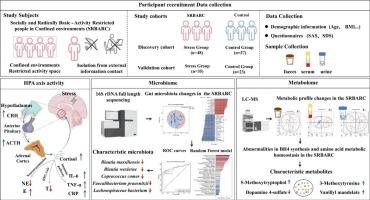封闭环境中特有微生物和代谢物的鉴定。
IF 7.6
2区 医学
Q1 IMMUNOLOGY
引用次数: 0
摘要
在密闭环境中的长期压力会破坏微生物-肠-脑轴。然而,在封闭环境(SRBARC)中,社会和根本基本活动受限的人(SRBARC)的特征性微生物和代谢变化仍不清楚。本研究综合评估了情绪状态、肠道微生物群和代谢组学特征,以研究SRBARC中它们的相互关系,旨在识别特征微生物和代谢物。结果表明,SRBARC倾向于表现出抑郁/焦虑样行为,并伴有下丘脑-垂体-肾上腺(HPA)轴激活、睾酮抑制和促炎细胞因子升高。全长16S rDNA测序分析表明,SRBARC的肠道菌群Shannon和Chao1指数较低。随机森林分析结合双队列验证提示马氏Blautia massiliensis、wexlerae Blautia、Coprococcus comes、Faecalibacterium prausnitii、Lachnospiraceae细菌可能是具有诊断价值的特征微生物(发现队列AUC = 0.836,验证队列AUC = 0.840)。粪便、血清和尿液的代谢组学分析显示,SRBARC中氨基酸代谢的改变和四氢生物蝶呤(BH4)合成的中断,影响了5-羟色胺(5-HT)和多巴胺(DA)途径。包括5-甲氧基色氨酸在内的四种代谢物被确定为与情绪状态相关的潜在代谢物。这些特征微生物和代谢特征与神经炎症和免疫有关,它们的相互作用可能在调节SRBARC的情绪状态中起关键作用。总之,本研究提示SRBARC中肠道微生物群、神经递质代谢和情绪状态之间存在潜在的相互作用,确定了潜在的关键微生物特征和代谢物,这可能为制定基于肠道微生物群的干预策略提供理论基础。本文章由计算机程序翻译,如有差异,请以英文原文为准。

Identification of characteristic microbes and metabolites in confined environments population
Chronic stress in confined environments can disrupt the microbiota-gut-brain axis. However, the characteristic microbial and metabolic alterations in socially and radically basic activity-restricted people in confined environments (SRBARC) remain unclear. This study integrated assessments of emotional states, gut microbiota, and metabolomic profiles to investigate their interrelationships in SRBARC, aiming to identify characteristic microbes and metabolites. The results suggested that the SRBARC tend to exhibit depressive/anxiety-like behaviors, accompanied by hypothalamic–pituitary–adrenal (HPA) axis activation, suppressed testosterone, and elevated pro-inflammatory cytokines. Full-length 16S rDNA sequencing analysis indicated lower Shannon and Chao1 indices in the gut microbiota of the SRBARC. Random forest analysis combined with dual-cohort verification suggested that Blautia massiliensis, Blautia wexlerae, Coprococcus comes, Faecalibacterium prausnitzii, and Lachnospiraceae bacterium may serve as characteristic microbes with diagnostic value (discovery cohort AUC = 0.836, validation cohort AUC = 0.840). Metabolomic analysis of feces, serum and urine revealed alterations in amino acid metabolism and disruptions in tetrahydrobiopterin (BH4) synthesis in the SRBARC, which affected serotonin (5-HT) and dopamine (DA) pathways. Four metabolites, including 5-methoxytryptophol, were identified as potentially metabolites associated with emotional states. These characteristic microorganisms and metabolic features were associated with neuroinflammation and immunity, and their interactions may play a key role in regulating emotional states in SRBARC. In summary, this study suggested a potential interplay among gut microbiota, neurotransmitter metabolism, and emotional states in the SRBARC, identifying potential key microbial signatures and metabolites that may provide a theoretical foundation for developing gut microbiota-based intervention strategies.
求助全文
通过发布文献求助,成功后即可免费获取论文全文。
去求助
来源期刊
CiteScore
29.60
自引率
2.00%
发文量
290
审稿时长
28 days
期刊介绍:
Established in 1987, Brain, Behavior, and Immunity proudly serves as the official journal of the Psychoneuroimmunology Research Society (PNIRS). This pioneering journal is dedicated to publishing peer-reviewed basic, experimental, and clinical studies that explore the intricate interactions among behavioral, neural, endocrine, and immune systems in both humans and animals.
As an international and interdisciplinary platform, Brain, Behavior, and Immunity focuses on original research spanning neuroscience, immunology, integrative physiology, behavioral biology, psychiatry, psychology, and clinical medicine. The journal is inclusive of research conducted at various levels, including molecular, cellular, social, and whole organism perspectives. With a commitment to efficiency, the journal facilitates online submission and review, ensuring timely publication of experimental results. Manuscripts typically undergo peer review and are returned to authors within 30 days of submission. It's worth noting that Brain, Behavior, and Immunity, published eight times a year, does not impose submission fees or page charges, fostering an open and accessible platform for scientific discourse.

 求助内容:
求助内容: 应助结果提醒方式:
应助结果提醒方式:


